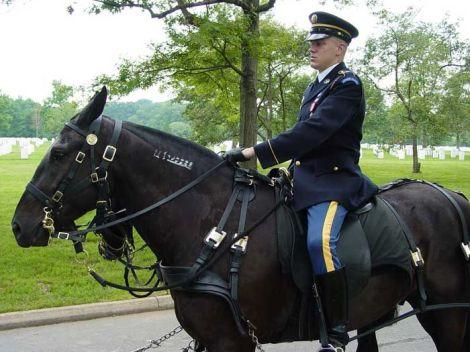You are viewing ARCHIVED content published online before January 20, 2025. Please note that this content is NOT UPDATED, and links may not work. Additionally, any previously issued diversity, equity, inclusion or gender-related guidance on this webpage should be considered rescinded. For current information, visit https://www.blm.gov/blog.
Mustangs in the U.S. Army
By Shawn Farnsworth, Wild Horse and Burro Program Specialist, BLM Southeastern States District
Did you know that the U.S. Army still utilizes horse detachments for service today? While there is a long history of cavalry use in the U.S. Army, most cavalry units were disbanded after 1939. It was in the 1960s that the modern Army began re-establishing horse detachments, using animals for ceremonial traditions, parades, and training missions.
Some examples of modern horse detachments include the Mounted Color Guard at Fort Carson, Colorado; Commanding Generals Mounted Color Guard in Fort Riley, Kansas; the 11th Armored Cavalry Regiment in Fort Irwin, California; First Cavalry Division Horse Detachment in Fort Hood, Texas; and the All-Volunteer Horse Detachment at Fort Huachuca, Arizona. While each of these horse detachments is unique, all still value the horse and U.S. Army traditions and many of them are using wild horses for remounts.
The presence of wild horses in the U.S. Army can be traced back to the early 1900’s when free-roaming horses from the American West were gathered to resupply the Army for the Spanish-American War and World War I. Today, the BLM works to train and supply saddle-broke horses to various U.S. Army units as part of its efforts to find good homes for animals gathered from overpopulated herds on public lands.
U.S. Army Units have found that once a wild horse has been trained, they become some of the best horses on the team. Mustangs demonstrate their talents every year, and have become great partners to many active service soldiers. The unique bond between soldiers and mustangs is very evident – even though soldiers are only detailed for only 1-2 years. At the end of their detail, soldiers turn their horse over to another soldier and the bonding and training starts again.
“I would love to see more mustangs at the detachments,” said Megan Zehnder, Fort Irwin Horse Trainer. “The three we have at Fort Irwin are so good for the program.”
Fort Riley has six mustangs on their team and is working with the BLM and the Northern Nevada Correctional Center to obtain an additional 3-5 horses within the next six months. Fort Riley, Fort Carson, and Fort Irwin also want to grow their detachments with more horses. Additionally, the Army is interested in obtaining more saddle trained horses so they can begin to replace the mustangs reaching retirement.










Related Content
Related Stories
- BLM recreation sites available to all: Exploring accessibility on California’s public lands
- A day on patrol with BLM Arizona Ranger Rocco Jackson
- Overcoming challenges to move the BLM forward: Nikki Haskett
- BLM recreation sites available to all: Exploring accessibility on Arizona’s public lands
- A day in the life of a BLM Hobbs Petroleum Engineering Technician
